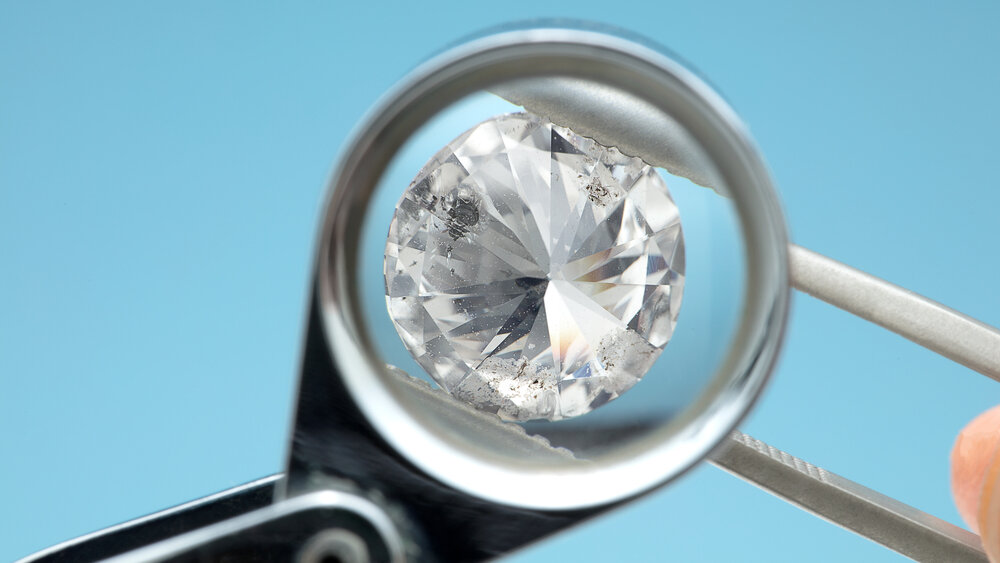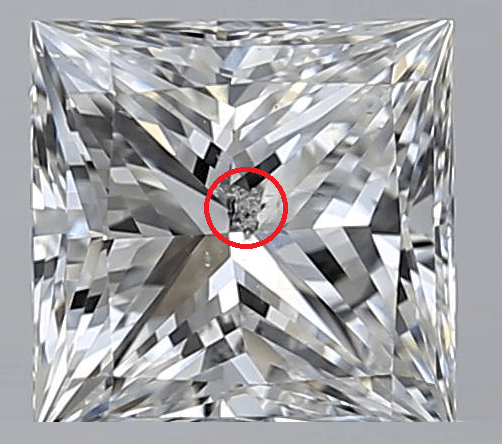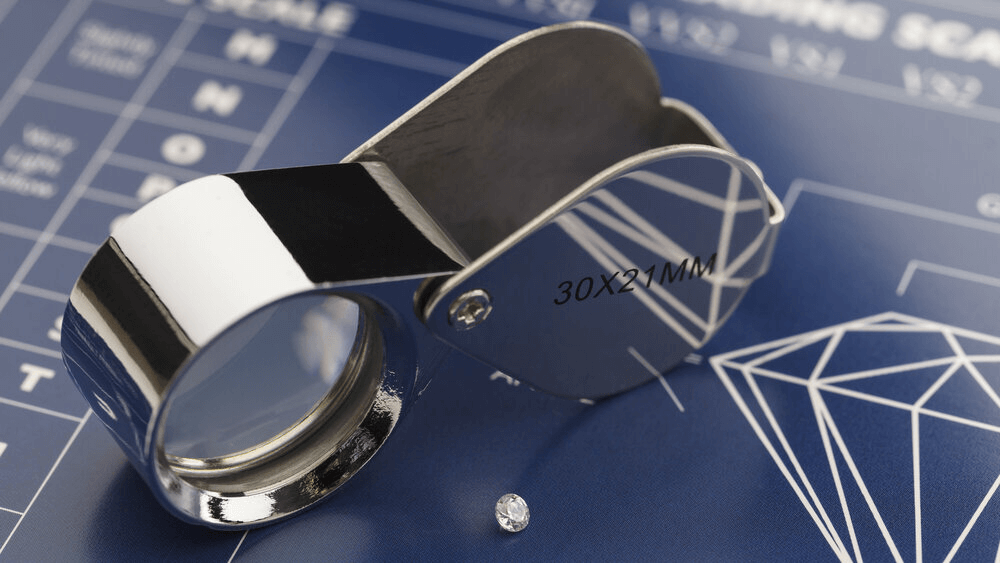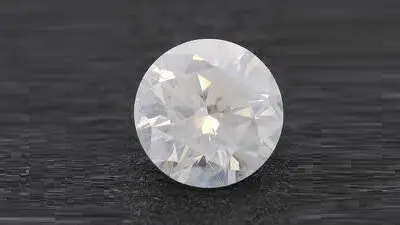A Must-Know Guide To I1 Diamond Clarity

By Gary A.

Edited by Olivia H.
Published Sep 9, 2021
Edited on Dec 17, 2024
Balancing beauty and budget, an I1 clarity diamond offers an affordable option for those seeking a larger stone while keeping inclusions minimal enough to maintain sparkle—could it be the right choice for you?

Navigate This Guide:
- 8 Quick Tips for Examining I1-I2 Diamond Clarity in Engagement Rings
- Introduction
- Overview of I1 Clarity
- The Role of I1 Diamonds in Engagement Rings
- Visual DIfferences and Impact on Aesthetics
- I1 Diamonds and Cost
- Our Expert Take
- 8 FAQs
Before we dive deeper into the specifics, here are some practical tips to help guide your decision-making process:
8 Quick Tips for Examining I1-I2 Diamond Clarity in Engagement Rings
- Tip 1: Understanding Clarity Grading: Educate yourself on the specifics of the I1 clarity to I2 clarity grading. Recognize that while these diamonds have noticeable inclusions, some may not be immediately apparent to the naked eye, particularly in smaller carat sizes. Research the types of inclusions typically found in I1-I2 diamonds, such as pinpoints, clouds, or feathers, to better understand what you might encounter.
- Tip 2: Prioritize Cut Quality Focus: on the cut quality of the diamond, as a well-cut diamond can enhance the stone’s overall brilliance and mask some inclusions. Opt for cuts that are known to conceal flaws effectively, like round or oval cuts, rather than cuts with large, open facets such as emerald cuts.
- Tip 3: Examine Under Various Lighting Conditions: View the diamond under different lighting environments, including natural daylight and artificial store lighting. This will help you see how the inclusions affect the diamond’s appearance in various settings. Inclusions in I1-I2 diamonds can sometimes be more or less visible under different lighting, impacting the stone’s aesthetics.
- Tip 4: Analyze the Location and Color of Inclusions: Pay attention to where the inclusions are located. Inclusions near the center or top of the diamond are more visible than those along the edges or corners. Consider the color of the inclusions. White or transparent inclusions are less noticeable than black or dark-colored ones.
- Tip 5: Evaluate Size and Carat Weight: Be aware that the size of the diamond can affect the visibility of inclusions. Larger diamonds might make inclusions more noticeable, while smaller ones can hide imperfections better. Decide on a balanced carat size that aligns with your preferences and the clarity grade. Sometimes, opting for a slightly smaller diamond can result in a better overall appearance.
- Tip 6: Consider the Ring Setting: Choose a ring setting that can help mask some of the inclusions. Certain settings, like bezel or halo, can cover peripheral inclusions effectively. Think about how the diamond’s placement in the setting might impact the visibility of inclusions, especially near the prongs or edges.
- Tip 7: Compare and Contrast: Compare multiple I1-I2 diamonds side by side if possible. This will give you a better sense of the variation within these clarity grades and help you find a stone that meets your standards for beauty and value. Remember that each diamond is unique, so take the time to find the one that appeals to you the most in terms of clarity, appearance, and overall sparkle.
- Tip 8: Focus on the Diamond’s Table for Visible Inclusions: When examining an I1 diamond, pay special attention to the table, which is the flat top surface of the diamond. This is often where inclusions can be most visible. Check if any visible inclusions are located directly under the table. Inclusions here can be more noticeable and may impact the diamond’s overall aesthetics more significantly than those located on the sides or bottom. A clear table can significantly enhance the appearance of an I1 diamond, making it appear cleaner and more brilliant despite its lower clarity grade.
Now that you’ve got these practical tips, use Jeweler AI below to find the perfect engagement ring that suits your style and budget:
Introduction
In the past, we’ve talked at length about how diamond inclusions – that is, those natural faults and blemishes that occur within the internal structure of the diamond during its long development under the earth’s surface – exist on a spectrum, and how many diamonds will appear flawless until you get them under powerful magnification.
This is, of course, in the shopper’s favor. Unlike collectors, you’re not looking for a ‘prize specimen’ – you’re looking for a beautiful diamond that won’t force you to go thousands of dollars outside of your original budget.
Still, there inevitably comes a point where ‘perfectly imperfect’ becomes, well, imperfect. Included diamonds (known via the GIA Clarity Scale as I1 and I2 diamonds) represent a definitive no-go area for anyone looking to create the perfect engagement ring – here’s why.
Overview of I1 Clarity
An abbreviation of ‘Included’, I1 and I2 diamonds represent the first and second degree of the lowest grade on the GIA Clarity Scale. They follow on from SI, or ‘Slightly Included’, diamonds.
By now, you may know a little about what inclusions really are. In essence, the term represents a variety of different flaws that can occur within the diamond – from black pinpoints to clouds and feathers. Most diamond inclusions are not visible to the naked eye, and require strong magnification – and maybe even an expert eye – to spot.
If visible, however, these can interfere with a diamond’s sparkle – not to mention the beauty of an otherwise clear and beautifully cut stone.
According to the GIA’s own definition for I1 and I2 Diamond Clarity, these stones will feature inclusions that are ‘obvious’ under 10x magnification – the standard strength of magnification used to determine all diamonds’ clarity grades. In this category, any diamond with significant and obvious inclusions will be found, making it the least advantageous place to look for your piece.
The Role of I1 Diamonds in Engagement Rings
So, should you choose an I1 diamond ring? Unfortunately, no – and we would never recommend anyone looking to find a diamond for use in jewelry (and particularly not an engagement ring) invest in an I2 or I1 clarity diamond.
The GIA Clarity Scale is, inarguably, the most trusted and widely used method for ascertaining the quality of diamonds bought and sold around the world. Its scale runs from the flawless grades FL and IF (Internally Flawless) through what are, in general, the ‘eye clean’ grades: VVS1 and VVS2, VS1 and VS2 and, in many cases, SI1. All else being equal, the price of any diamond will decrease as it goes further down the scale. The I1 diamond price, then, would be considered at the lower end of the spectrum.
As you can see, according to this scale, there are many opportunities to find an eye clean diamond (and at increasingly affordable prices) before you reach the visibly imperfect I1 clarity diamond or, worse still, I2.

Visual DIfferences and Impact on Aesthetics
There’s really only a small difference between any of the clarity grades, but I2 is the very lowest clarity grade the GIA gives to diamonds, which does mean that it’ll stand out to you. Most I2 diamonds will be quite obviously included – but so will I1 diamonds. For very small diamonds with brilliant facets, however, an I1 diamond may just about appear eye clean. This is rarely the case for I2 diamonds.
When comparing SI2 and I1 diamonds, it’s important to understand that while SI2 diamonds often strike a good balance between clarity and cost, I1 diamonds generally have more prominent inclusions that are easily visible without magnification, particularly in larger stones.

Is an I1 Diamond Eye Clean?
In all likelihood, no – I1 diamonds will feature numerous flaws significant enough to be seen without 10x magnification unless the diamond in question is very small – meaning the I1 diamond quality will be obvious.
Eye clean diamonds are, in a nutshell, diamonds that appear flawless even though inclusions have been identified under 10x magnification by diamond grading experts. They are an excellent example not only of the long spectrum that exists between FL graded diamonds, and diamonds that appear flawless but also of the quality those on tighter budgets can still find.
One important thing to note is size. Just as smaller SI1 diamonds can be eye clean, and larger SI1 diamonds tend to show their inclusions, so too can I1 and I2 diamonds.
In general, diamonds with a clarity grade of I1 will only stand a chance of appearing eye clean if they are very small – below, say, half a carat. Obviously, with the average engagement ring being 1 carat or higher, this means a much smaller size than most shoppers are looking for. An I1 diamond ring wouldn’t stand out on a finger.
The best way to determine if an I1 diamond really is eye clean is to check out the diamond’s GIA Report and compare the diamond with the plot provided. Also, if you’re shopping from a reputable seller (like us), you can put plenty of trust into the ‘screening process’ that takes place before the diamond goes on sale. You won’t need to approach i1 diamonds for sale blind.Our resident diamond expert has decades of experience in the diamond world and knows what separates a sound investment from a waste of money.
Will an I1 I2 Diamond Sparkle?
Yes, but it is unlikely to sparkle anywhere near as much as an eye clean diamond of the same cut and shape.
We’ve said it before, and we’ll say it again: cut is by far the most important feature in any diamond when it comes to maximizing sparkle.
This 2.01 G-VS2 Round Diamond is an example of a diamond cut to ensure the most brilliance possible – meaning that, on the finger, it will create a dazzling light performance of bright flashes and shimmers. At the other end of the scale, this 2.01 Carat H-VS1 Emerald Diamond, while featuring a higher clarity grade, will shine a little differently and, while beautiful, without the electric shimmer of the round cut.
Nevertheless, in extreme cases, clarity does matter to sparkle. While, provided you choose an eye clean diamond, you won’t need to worry about any loss of brilliance, fire or scintillation, visible inclusions can derail the journey light makes through the diamond, and, as a result, impair sparkle.
Don’t get us wrong – unless you’ve got a cloudy diamond on your hands, it’ll still have plenty of shine to its name, but nowhere near as much as it could have.
The Unique Appeal of I1 Diamond Clarity
For some people, included diamonds hold their own appeal. These are sometimes referred to as salt and pepper diamonds, since they appear to be flecked with little inclusions visible throughout the diamond’s table and girdle.
While some people intentionally seek out visibly included ‘salt and pepper’ diamonds, however, it’s important to remember that the majority of people prefer diamonds to look eye clean. Unless you’re absolutely certain that your partner wants a technically ‘low quality’ diamond, steer clear.
I1 Diamonds and Cost
I1 diamonds hold another favorable quality: they’re significantly cheaper. But be careful – affordability isn’t the same as value for money, and you may just end up paying too much for too little.
How Much is a 1 Carat I1 Diamond?
Despite their visible flaws, I1 diamonds will still typically cost around $2,000+ — although they will of course cost less than comparable diamonds with a higher clarity grade.
Yes, opting for a diamond with an I1 clarity grade is a surefire way of saving a little money – though, the reduced I1 diamond price is pretty unlikely to be worthwhile. After all, included diamonds still hold plenty of value – just not for fine jewelry.
In other words, while there is (obviously) a noticeable difference in cost between an I1 diamond and an eye clean SI1 or VS2 diamond, that difference is not as significant as some people might imagine it to be. You won’t necessarily be saving thousands and thousands of dollars – particularly when you consider the fact that even SI1 diamonds offer plenty of eye clean options at an affordable price point.
I1 Diamonds as a Budget Friendly Option
We’re not saying that every I1 or I2 diamond ever purchased was a total flop. We are, however, saying that making an investment of this size into a diamond that, in all likelihood, features inclusions large enough to register with the naked eye, is definitely a big risk.
Those looking for diamond engagement rings don’t need to decide whether they’re a part of the (very, very small) minority who can afford flawlessness, or, alternatively, a part of the majority who have to settle for visible imperfections.
Also, by now – and even if you’re daunted by the prospect – you’ve probably already got a few ideas in mind for the sort of ring you want to present to your future bride. If you’re forced to curtail your creativity and work to hide your diamond’s inclusions, it’s pretty likely that you won’t be able to stick to that original vision.
Even if you feel okay with a visibly included diamond right now, this is not the sort of purchase you want to be having second thoughts over. Eye clean diamonds are great because, once purchased, we can forget all about any inclusions marked down within their GIA report – although the same can’t be said for I1 and I2 diamonds.
Our Expert Take
So, is Diamond I! Clarity or I2 Clarity Bad? It’s far from ideal, particularly when you are looking to find the right center stone for your engagement ring. While a lucky few might find a passable diamond at this clarity grade, it’s highly unlikely and may require some pretty big sacrifices on your part.
Don’t feel discouraged – finding an affordable engagement ring is definitely possible, but it should never be at the sacrifice of eye cleanliness. For that reason alone, consider an I1 diamond ring – and I2 – the wrong place to start – or end – your search for a diamond.
8 FAQs
- Q: What Does ‘I1’ in Diamond Clarity Mean?
- A: I1 stands for ‘Included 1’, indicating a clarity grade where inclusions are visible to the naked eye or under 10x magnification, but they are typically less obvious than in lower grades like I2 or I3.
- Q: Are I1 Diamonds a Good Choice for Engagement Rings?
- A: Yes, I1 diamonds can be a good choice for engagement rings, especially if you’re seeking a balance between size, beauty, and budget. An I1 diamond engagement ring often offers a more affordable option without significantly compromising on appearance. This should answer the ‘are i1 diamonds worth buying’ question.
- Q: Can You See Inclusions in an I1 Diamond?
- A: Yes, inclusions in an I1 diamond are often visible to the naked eye, but their visibility depends on the size, number, and location of these inclusions.
- Q: How Does an I1 Diamond Compare to an I2 Diamond?
- A: I1 diamonds generally have fewer and less noticeable inclusions compared to I2 diamonds. This means I1 diamonds typically have better clarity and are more aesthetically pleasing.
- Q: What Should I Look for When Buying an I1 Diamond?
- A: Focus on the cut, color, and placement of inclusions. Look for inclusions that are less visible or strategically placed where they can be concealed by the setting.
- Q: Do I1 Diamonds Sparkle Less?
- A: The sparkle of an I1 diamond can be impacted by inclusions, but a well-cut I1 diamond can still exhibit significant brilliance and fire, especially if the inclusions are strategically located.
- Q: Is I1 Diamond Clarity Good for Large Diamonds?
- A: For larger diamonds, inclusions in the I1 grade may be more visible. It’s crucial to inspect the diamond thoroughly or consider a slightly higher clarity grade for larger stones.
- Q: Can I1 Diamonds Increase in Value Over Time?
- A: Like most diamonds, I1 diamonds can maintain or increase in value depending on market conditions. However, they may not appreciate as much as higher clarity grades.
Explore the brilliance of I1 diamonds with Jeweler AI. Discover your perfect match in the world of clarity and sophistication.
FOLLOW-UP GUIDE SERIES





















